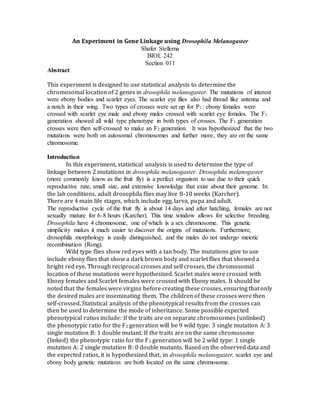Melden
Teilen

Empfohlen
Empfohlen
Weitere ähnliche Inhalte
Was ist angesagt?
Was ist angesagt? (20)
Ähnlich wie FLIES
Ähnlich wie FLIES (20)
Using P-Element Induced Male Recombination To Generate A...

Using P-Element Induced Male Recombination To Generate A...
oo Sprint F 1017 PM Files Practice Exam 2 answers.docx 5. Curly wing.pdf

oo Sprint F 1017 PM Files Practice Exam 2 answers.docx 5. Curly wing.pdf
Study Guide Chapter 15 -Chromosomal Basis of Inheritance-Answers.docx

Study Guide Chapter 15 -Chromosomal Basis of Inheritance-Answers.docx
FLIES
- 1. An Experiment in Gene Linkage using Drosophila Melanogaster Shafer Stellema BIOL 242 Section 011 Abstract This experiment is designed to use statistical analysis to determine the chromosomal location of 2 genes in drosophila melanogaster. The mutations of interest were ebony bodies and scarlet eyes. The scarlet eye flies also had thread like antenna and a notch in their wing. Two types of crosses were set up for P1 : ebony females were crossed with scarlet eye male and ebony males crossed with scarlet eye females. The F1 generation showed all wild type phenotype in both types of crosses. The F1 generation crosses were then self-crossed to make an F2 generation. It was hypothesized that the two mutations were both on autosomal chromosomes and further more, they are on the same chromosome. Introduction In this experiment, statistical analysis is used to determine the type of linkage between 2 mutations in drosophila melanogaster. Drosophila melanogaster (more commonly know as the fruit fly) is a perfect organism to use due to their quick reproductive rate, small size, and extensive knowledge that exist about their genome. In the lab conditions, adult drosophila flies may live 8-10 weeks (Karcher). There are 4 main life stages, which include egg, larva, pupa and adult. The reproductive cycle of the fruit fly is about 14 days and after hatching, females are not sexually mature for 6-8 hours (Karcher). This time window allows for selective breeding. Drosophila have 4 chromosome, one of which is a sex chromosome. This genetic simplicity makes it much easier to discover the origins of mutations. Furthermore, drosophila morphology is easily distinguished, and the males do not undergo meiotic recombination (Rong). Wild type flies show red eyes with a tan body. The mutations give to use include ebony flies that show a dark brown body and scarlet flies that showed a bright red eye. Through reciprocal crosses and self crosses, the chromosomal location of these mutations were hypothesized. Scarlet males were crossed with Ebony females and Scarlet females were crossed with Ebony males. It should be noted that the females were virgins before creating these crosses, ensuring that only the desired males are inseminating them. The children of these crosses were then self-crossed. Statistical analysis of the phenotypical results from the crosses can then be used to determine the mode of inheritance. Some possible expected phenotypical ratios include: If the traits are on separate chromosomes (unlinked) the phenotypic ratio for the F2 generation will be 9 wild type: 3 single mutation A: 3 single mutation B: 1 double mutant. If the traits are on the same chromosome (linked) the phenotypic ratio for the F2 generation will be 2 wild type: 1 single mutation A: 2 single mutation B: 0 double mutants. Based on the observed data and the expected ratios, it is hypothesized that, in drosophila melanogaster, scarlet eye and ebony body genetic mutations are both located on the same chromosome.